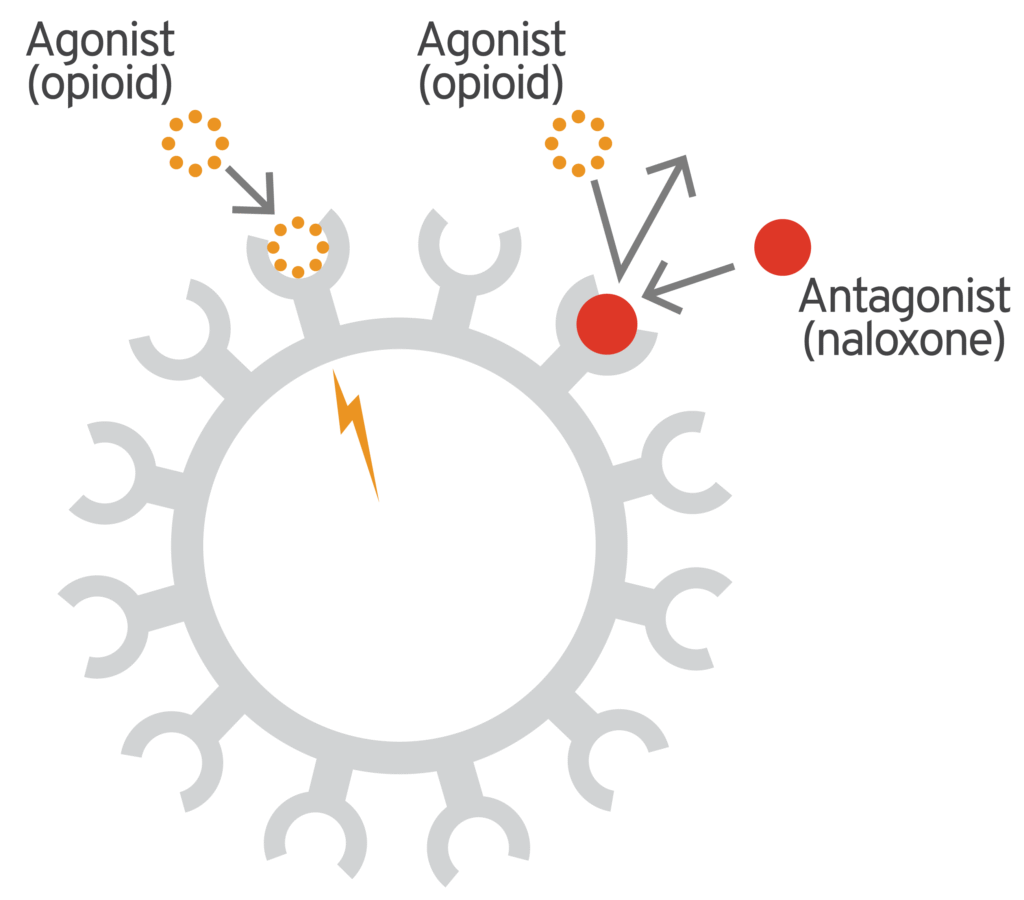Opioids are Getting More Potent. What About Naloxone?
Author
Media Contact
For general and media inquiries and to book our experts, please contact: pr@rstreet.org
How Drugs Produce Their Effects
Drugs produce effects by binding to receptors
When someone takes a drug, many processes affect what happens to the body. Each drug has characteristics that allow it to interact with receptors on cells like a lock and key. A drug that only binds to one receptor is highly selective, while one that binds to many receptors has low selectivity (i.e., how many locks does a key fit?). Some drugs are more strongly drawn to receptors than others. The strength of the attraction and bond between the drug and the receptor is known as pharmacological affinity (i.e., how well does the key fit the lock?). Just because the high affinity drug binds more strongly and readily with receptors does not necessarily mean it produces any stronger or noticeable effects. The ability of a drug to cause an effect on the body is its efficacy (i.e., can the key turn the lock?). “Antagonists” are drugs that can bind to receptors but lack the efficacy to create a response; conversely, “agonists” are drugs with both affinity and efficacy for a binding site.

If a person takes certain antagonists along with agonists that compete for the same receptors, then the antagonist neutralizes the agonist’s effects. This is what happens when an opioid overdose is reversed using naloxone.
Effects vary based on a drug’s strength and quantity
“Potency” refers to the amount of a drug needed to produce the desired effects and is determined by a drug’s affinity and efficacy. Potency is most meaningfully interpreted when comparing the dose of two or more drugs required to produce the same effect. For example, distilled spirits are more potent than beer because a smaller amount of spirits produces the same effect as a larger amount of beer. A related concept is “dose-response,” which refers to the amount of a substance required to produce the desired result. This relationship depends on multiple factors, including how the drug is administered as well as its pharmacological properties and individual biological differences. With some (but not all) drugs, if someone takes a larger dose, then the desired effects are stronger, at least to a point; however, larger doses can also increase the risk of toxicity and unwanted effects.
Individual differences affect a drug’s effects
How a drug affects the body depends on the interplay of these characteristics along with other factors inherent to the drug and unique to individuals. For example, people who regularly consume a drug may develop tolerance to its effects. Tolerance is caused by changes in the way the body reacts to the presence of a drug and means the person will require larger doses—or more potent varieties—of a drug to achieve the same effects over time. That is, tolerance changes the dose-response. Additionally, other factors like weight, hydration, genetics, and underlying medical conditions can affect how different people react to the same quantity of a drug.
Case Study: Increased Opioid Potency and Overdose
The opioid overdose crisis has put a spotlight on drug potency. The increase in overdose deaths from fentanyl’s incorporation into the drug supply showed the effects of increased potency, especially when its presence is not known or expected. Now, as even stronger opioids like nitazenes appear in drug supplies, there is concern about the destruction these substances could leave in their wake.
| OVERDOSE | The risk of a drug causing an overdose is determined by the interaction between its affinity, efficacy, potency, and selectivity, along with a person’s individual biology and social environment. Regardless of the substance, overdose can occur if the amount of a drug in the body overwhelms the body’s ability to process and eliminate it. An opioid overdose occurs when opioid receptors are overstimulated, which causes a person’s respiratory processes to slow, sometimes leading to death. Because the risks of opioid overdose and death from opioid overdose depend on multiple factors, it is difficult to isolate the effect of each drug characteristic. Generally, the higher an opioid’s potency, the higher the risk of overdose and overdose death. More potent opioids have a smaller margin of error for dosing and tend to cause overdose symptoms more quickly, thereby increasing the risk of overdose and death from overdose. |
| OVERDOSE REVERSAL | Naloxone is able to reverse opioid overdoses because it is an opioid antagonist. Naloxone reverses an overdose by competing with the opioid for receptor sites. Naloxone has high affinity but no efficacy. This means it binds strongly to receptors, preventing the opioid molecules from attaching, but creates no physical effects. Naloxone can also displace already attached molecules from the receptors. This blocking of receptors reduces the effects of the opioid and reverses the overdose. Think about naloxone as a plastic electrical outlet plug used to childproof a house. As more potent opioids have entered the illicit drug supply, conversations about the need for higher doses of naloxone have increased. The faster onset of overdose symptoms from more potent opioids means that respiratory depression occurs more quickly, leaving a smaller window in which to intervene and reverse the overdose. However, naloxone works quickly and can produce effects in as soon as one minute depending on the route of administration. But its effects also wear off relatively quickly (30-80 minutes), often faster than the effects of an opioid. This can sometimes cause a person’s overdose symptoms to return after naloxone administration, requiring more than one dose over time. However, higher potency alone does not automatically necessitate higher dose naloxone. Rather, of an opioid’s characteristics, its affinity—which often (but not always) increases with potency—relates most to naloxone’s ability to displace it. That is, regardless of an opioid’s potency, if naloxone’s receptor affinity is higher than the opioid’s, then it can displace the opioid molecules causing the overdose. On the other hand, if a substance has lower potency but higher affinity than naloxone, then naloxone would likely not work as well. Because of this, a specific opioid’s affinity is more predictive of the need for additional or higher doses of naloxone than its potency. |
Conclusion
Since time is of the essence when responding to an overdose, it is understandable to think that a larger dose of naloxone is always better. However, that is not universally true. Although more potent opioids can cause more rapid overdose onset and greater respiratory depression, potency does not always indicate a higher binding affinity. Conversely, unnecessarily higher naloxone doses can cause a person to experience rapid and severe withdrawal symptoms.
Each overdose scenario is different. In an ideal world, naloxone dose and timing would be personalized to restore breathing without preventing the person from experiencing withdrawal symptoms. It is critical to administer naloxone as early as possible during an overdose, and continued medical monitoring is the best way to ensure the person receives appropriate follow-up care. Overdose is a complex medical emergency, but the reality of naloxone administration is simple: More is not always better, but some is always better than none.
